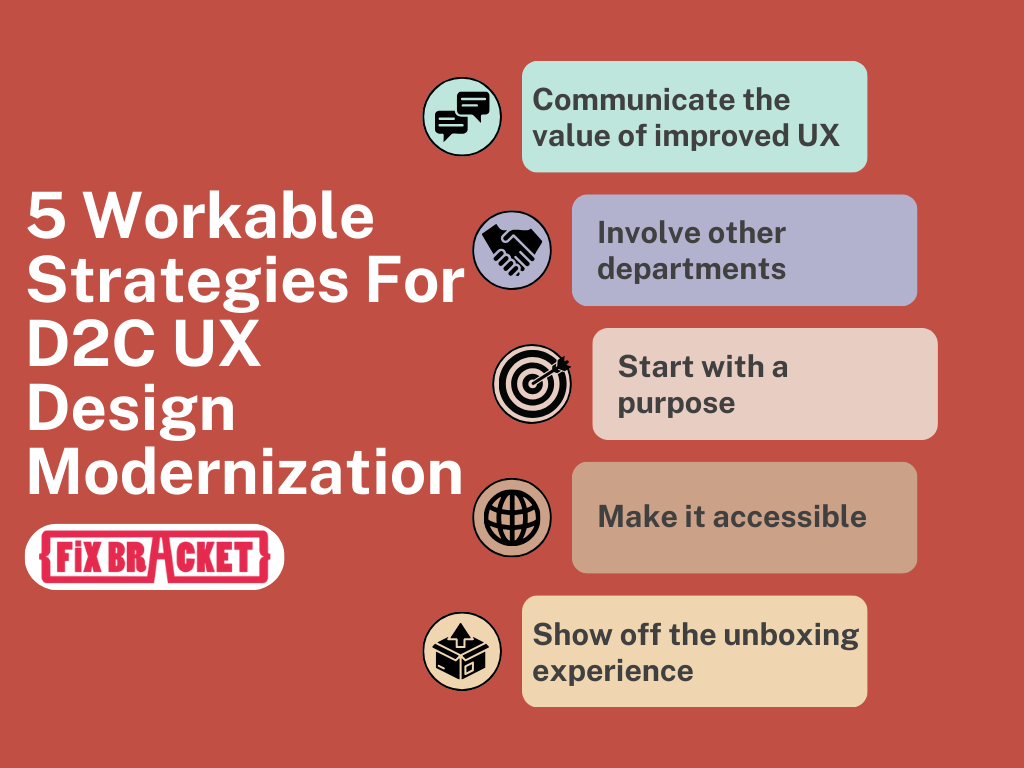
When we plunge into the world of internet technology, two key players steal the spotlight: the user interface (UI) and user experience (UX). They’re the invisible architects shaping the success of a website or app. And in this post, we’ll primarily be talking about D2C UX.
Think about it: how a website looks and feels can sway user actions—will they make a purchase or just click away? In today’s business scene, it’s a critical factor.
D2C UX is like the whole atmosphere users perceive—the aesthetics, the usability, everything.
How D2C Brands Differ From Other Brands
D2C brands stand out notably from traditional brands in their direct relationship with customers. This model ensures transparency, assuring consumers that they’re receiving products directly from the brand itself. Especially with the surge in e-commerce, customers now expect seamless online transactions.
One distinctive aspect of D2C brands is the elimination of intermediaries, allowing for a more direct connection between brand and consumer. This not only enhances customer satisfaction but also retains more profits within the brand.
Beyond this, the D2C approach provides invaluable insights into customer data. By segmenting demographics and understanding individual preferences, brands can tailor their offerings more precisely.
Owning a D2C brand affords greater control over brand reputation compared to conventional retail brands. The direct interaction with end customers facilitates a deeper understanding of their needs and enables brands to meet those expectations more effectively.
This closeness to consumers fosters brand loyalty and trust.
Why Is D2C UX Modernization Important?
In today’s ever-expanding digital realm, the significance of a high-quality and contemporary user experience cannot be overstated. It directly shapes how customers perceive your business, interact with your products, and establish communication channels.
The tangible impact of D2C UX modernization is underscored by concrete statistical evidence:
Research from Forester suggests that a well-crafted user interface can amplify a website’s conversion rates by up to 200%.
Investing in UX design to enhance customer satisfaction by a mere 5% can lead to a remarkable profit surge of at least 25%.
The correlation is evident—the more a company focuses on modernizing its UX, the more likely it is to thrive. This is especially true for D2C UX for direct-to-consumer businesses.
Benefits of D2C UX Modernization
Upgrading your D2C UX opens the door to an array of advantages, each contributing to the overall success and growth of your business:
- Boosting Revenue:
Elevating revenue is a primary objective for most businesses, and UX can be a game-changer. According to Forrester’s research, every dollar invested in UX generates an average return of $100—a staggering 9,900% ROI. - Cost Optimization:
UX involves understanding customer behavior, deciphering optimal website interactions, and meeting user experience needs. Analyzing user behavior helps in resource allocation, allowing businesses to invest where it truly matters. - Enhancing Accessibility:
Modern companies must integrate accessibility into their D2C UX. Making systems and applications accessible to individuals with disabilities expands the audience and augments the organization’s reputation. - Elevating User Satisfaction:
User satisfaction is pivotal in defining the user experience. A poorly designed site adversely impacts customer satisfaction, with 60% of customers citing bad experiences as reasons for website abandonment. - Customer Retention:
Improving user satisfaction is crucial for sustained business success. A visually appealing and swift user interface retains customer interest and encourages repeat visits. Loyal customers are more likely to make repeat purchases and refer others, significantly impacting revenue. - Scalability:
Adaptability is key for growing companies. Leveraging modern UI designs enables companies to align with evolving customer needs and technological advancements, facilitating excellent functionality and addressing pain points.
In essence, prioritizing D2C UX modernization reaps multifaceted benefits, driving revenue, enhancing customer satisfaction, and ensuring sustained business growth in the ever-evolving digital landscape.
Elevate Your User Experience: Strategies for Successful D2C UX Modernization

Strategize, Plan & Execute
Image source: Freepik.com
Revamping your User Experience (UX) is a multifaceted endeavor that transcends mere aesthetics. It’s about crafting an environment that resonates with your audience, making navigation seamless, and creating an inclusive space for all users.
Let’s delve into specific D2C UX design strategies that can help breathe new life into your direct-to-consumer business.
Don’t be afraid of the big picture
Your website’s visuals set the stage for your brand’s identity. Particularly on the landing page, aim for a striking, memorable image that captivates your audience. Limit the text to keep visitors engaged and intrigued, allowing the imagery to initiate your brand’s narrative.
Don’t be too literal
Visual storytelling isn’t about a direct depiction of product use. Engage creativity to convey a sense of lifestyle, fun, or abstract representation. Move away from generic stock photos; invest in visuals that embody your brand’s uniqueness and resonate with your audience on a deeper level.
Tell a story
Your brand has a story—share it! Allocate space on your site to communicate your mission, values, and the journey that led to your establishment. Whether it’s sustainability initiatives or ethical practices, let your brand’s story resonate and connect with your audience.
Brag about the goodness
If your product boasts exceptional features or benefits, flaunt them! Clearly articulate your product’s positive attributes, be it cruelty-free ingredients, sustainable practices, or any distinguishing qualities that set it apart.
Be transparent
Transparency breeds trust. Provide a clear understanding of how your product works and ensure transparent pricing. Avoid hidden fees or misleading information; clarity from the get-go facilitates informed decision-making.
A little bit of humor won’t hurt
Incorporate humor thoughtfully and in alignment with your brand’s personality. Well-placed humor can leave a lasting, positive impression, adding a touch of relatability to your brand.
Sell a lifestyle
Shift focus from mere product listings to showcasing the lifestyle your products embody. Enable your customers to visualize themselves engaging with your products in their everyday lives, elevating the emotional connection with your brand.
5 Workable Strategies For D2C UX Design Modernization

We’ve looked mainly into generic strategies that anybody can use, not only limited to D2C UX. Now let’s check out some direct and workable strategies that we can use as a D2C business owner.
Communicate the value of improved UX
Educate stakeholders on how enhanced UX directly impacts brand success and customer satisfaction. Demonstrate how an improved UX aligns with business goals and fosters better engagement.
Cross-work and maintain cooperation between all departments
Promote collaboration across teams and departments. Encourage diverse viewpoints to gain holistic insights and ensure everyone contributes to the overarching UX objectives.
Start with a purpose
Define specific goals for your UX improvements. Clarify the outcomes you aim to achieve rather than making generalized changes. Establish a clear direction for your UX modernization efforts.
Make it accessible
Inclusivity is paramount. In the digital age, designing for accessibility is not just an option but a necessity. Consider the diverse needs of users, including those with disabilities. Ensure your site complies with accessibility standards, from color contrast to font sizes, facilitating a seamless experience for all visitors.
Show off the packaging
The unboxing experience matters more than you might think. Display the packaging aesthetics and the experience of opening your product. A memorable unboxing creates excitement and anticipation, enhancing the overall customer experience.
Enhancing your D2C UX transcends surface-level changes; it’s about crafting an immersive, accessible, and engaging digital space. Employing these strategies will not just elevate your brand’s online presence but also foster deeper connections, leading to enduring brand loyalty and success.
Conclusion
Ensuring a great product is just the beginning; the experience surrounding it is equally crucial.
Focusing on the journey your customers go through can make all the difference. It’s about making every interaction, and every touchpoint memorable and enjoyable. This becomes especially true for D2C UX design.
By putting your customers at the forefront, and ensuring their journey is smooth and satisfying, you’re not just selling a product — you’re offering an experience. This emphasis on their experience is what ultimately captures their loyalty and keeps them coming back for more.
After all, it’s not just about the product; it’s about the lasting impression your brand leaves.
People Also Read:
The Outcome Of A Good UX Design In Fintech
UX Design Presentation To Knock Their Socks Off!




